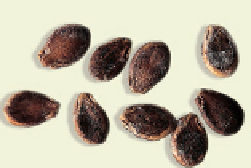Agriculture Reference
In-Depth Information
DISEASES AND PESTS
Cucumber scab, caused by the fungus
Cladiosporum cucumerinum
, can be seed-
borne. Symptoms include black, sunken-in spots on fruits and sometimes leaves. A jelly-like substance
also appears with the spots on the fruits. Fungus on the leaves eventually eats through the tissue, leav-
ing behind holes. The fungus grows ideally at 72-73°F (22-23°C), so where temperatures can be
brought far above this, as in a greenhouse, the fungus can be effectively kept under control.
The pathogen causing anthracnose, the fungus
Colletotrichum orbiculare
, can also be seed-borne.
Symptoms: seedlings from infected seed develop “burn spots” and then die. On the leaves of mature
plants, small yellow spots that then turn brown appear. Round, brown or black spots form in depres-
sions on the surface of the fruit. Remedies: thorough destruction of plant material, disinfection of tools
and hands, crop rotation of at least three years.
Hami melon
From ssp.
agrestis
comes this special variety. Under ideal conditions, the snow melon (as it is
also known) can produce large fruits (8 by 12 in. [20 by 30 cm]). What makes this variety so
unique is that ripe fruits burst at their tips. The snow-white flesh has a foamy consistency and a
strong melon aroma. In South America, Hami melons are made into a delicious beverage by pur-
eeing them and mixing them with honey.
CULTIVATION HISTORY
The melon is an Old World plant. Wild forms of ssp.
melo
are found in sub-
tropical central Asia and in the Middle East, whereas wild forms of ssp.
agrestis
are found in the trop-
ical areas of the Old World. The melon was domesticated several times in several different places,
leading to the diversity we know today. The oldest finds of seeds are from Egypt (3800-3500
BC
) and
China (circa 3000
BC
). The oldest finds in Europe come from Greece (1400-900
BC
).
WATERMELON
Citrullus lanatus
The deliciously refreshing watermelon is the most widely traded cucurbit in the world, with many hy-
brid varieties offering few seeds and thin rinds. Fruits often have red flesh, but there are also yellow-,
green-, and white-fleshed varieties. Plants are usually covered with small hairs and have pinnate
leaves, making them easy to distinguish from muskmelon vines, with which they are sometimes con-
fused. In some countries, like China, varieties with high-oil-content seeds are grown; the seeds are
then roasted and eaten as a snack. Other varieties are grown specifically as livestock feed.


